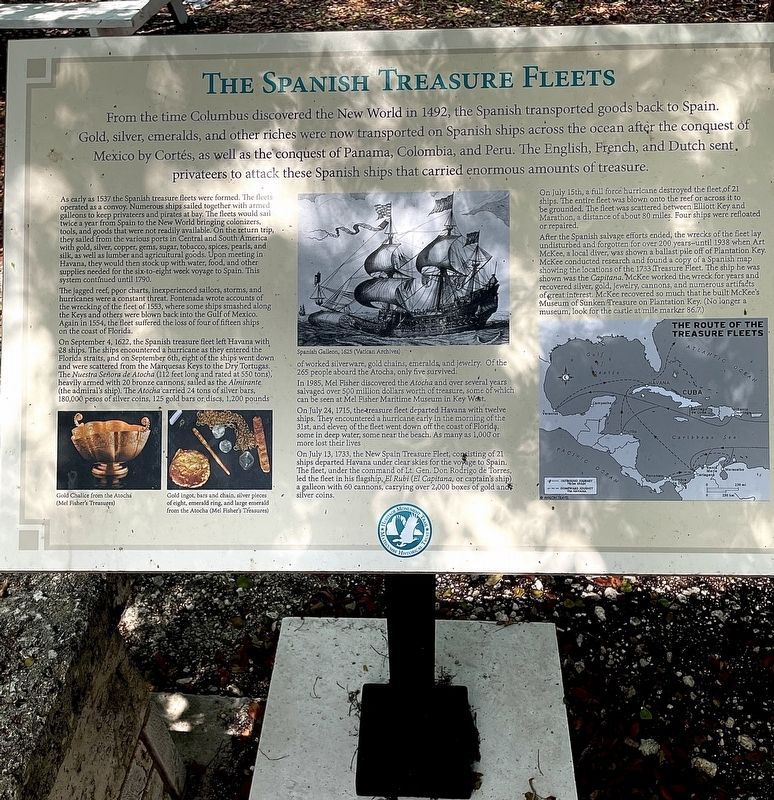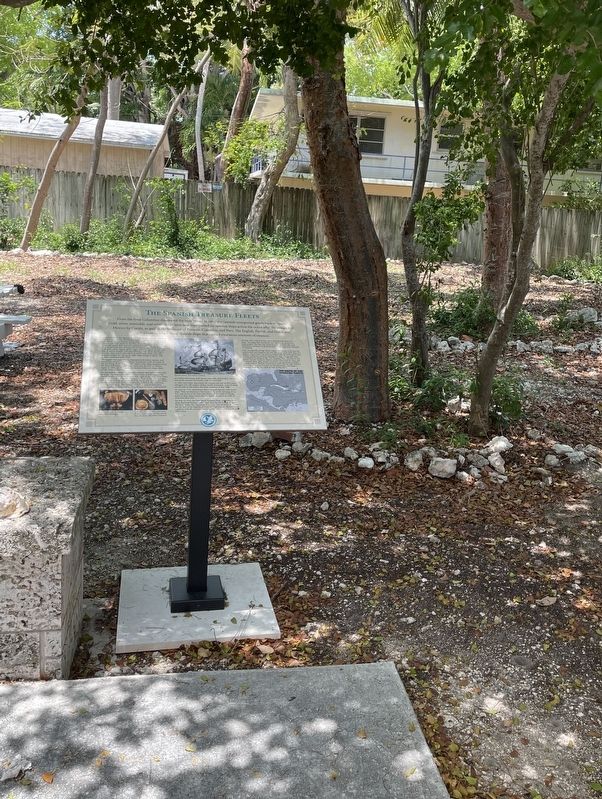Islamorada in Monroe County, Florida — The American South (South Atlantic)
The Spanish Treasure Fleets
Heritage Monument Trail, Matacumbe Historical Trust
From the time Columbus discovered the New World in 1492, the Spanish transported goods back to Spain. Gold, silver, emeralds, and other riches were now transported on Spanish ships across the ocean after the conquest of Mexico by Cortés, as well as the conquest of Panama, Colombia, and Peru. The English, French, and Dutch sent. privateers to attack these Spanish ships that carried enormous amounts of treasure.
As early as 1537 the Spanish treasure fleets were formed. The fleets operated as a convoy. Numerous ships sailed together with armed galleons to keep privateers and pirates at bay. The fleets would sail twice a year from Spain to the New World bringing colonizers, tools, and goods that were not readily available. On the return trip, they sailed from the various ports in Central and South America with gold, silver, copper, gems, sugar, tobacco, spices, pearls, and silk, as well as lumber and agricultural goods. Upon meeting in Havana, they would then stock up with water, food, and other supplies needed for the six-to-eight week voyage to Spain. This system continued until 1790.
The jagged reef, poor charts, inexperienced sailors, storms, and hurricanes were a constant threat. Fontenada wrote accounts of the wrecking of the fleet of 1553, where some ships smashed along the Keys and others were blown back into the Gulf of Mexico. Again in 1554, the fleet suffered the loss of four of fifteen ships on the coast of Florida.
On September 4, 1622, the Spanish treasure fleet left Havana with 28 ships. The ships encountered a hurricane as they entered the Florida straits, and on September 6th, eight of the ships went down and were scattered from the Marquesas Keys to the Dry Tortugas. The Nuestra Señora de Atocha (112 feet long and rated at 550 tons); heavily armed with 20 bronze cannons, sailed as the Almirante (the admiral's ship). The Atocha carried 24 tons of silver bars, 180,000 pesos of silver coins, 125 gold bars or discs, 1,200 pounds of worked silverware, gold chains, emeralds, and jewelry. Of the 265 people aboard the Atocha, only five survived.
On July 24, 1715, the treasure fleet departed Havana with twelve ships. They encountered a hurricane early in the morning of the 31st, and eleven of the fleet went down off the coast of Florida, some in deep water, some near the beach. As many as 1,000 or more lost their lives
On July 13, 1733, the New Spain Treasure Fleet, consisting of 21 ships. The fleet, under the command of Lt. Gen. Don Rodrigo de Torres, led the fleet in his flagship, El Rubi (El Capitana, or captains ship) a galleon with 60 cannons, carrying over 2,000 boxes of gold and silver coins.
On July 15th, a full force hurricane destroyed the fleet of 21 ships. The entire fleet was blown onto the reef or across it to be grounded. The fleet was scattered between Elliott Key and Marathon, a distance of about 80 miles. Four ships were refloated and repaired.
After the Spanish salvage efforts ended, the wrecks of the fleet lay undisturbed and forgotten for over 200 years-until 1938 when Art McKee, a local diver, was shown a ballast pile off of Plantation Key. McKee conducted research and found a copy of a Spanish map showing the locations of the 1773 Treasure Fleet. The ship he was shown was the Capitana. McKee worked the wreck for years and recovered silver, gold, jewelry, cannons, and numerous artifacts of great interest. McKee recovered so much that he built McKee's Museum of Sunken Treasure on Plantation Key. (No longer a museum, look for the castle at mile marker 86.7)
(Captions)
Gold Chalice from the Atocha (Mel Fisher’s Treasures)
Gold ingot, bars and chain, silver pieces of eight, emerald ring, and large emerald from the Atocha (Mel Fisher's Treasures)
Erected by Heritage Monument Trail, Matacumbe Historical Trust.
Topics. This historical marker is listed in these topic lists: Anthropology & Archaeology • Disasters • Exploration • Waterways & Vessels. A significant historical date for this entry is September 4, 1622.
Location. 24° 55.576′ N, 80° 37.581′ W. Marker is in Islamorada, Florida, in Monroe County. Marker can be reached from Overseas Highway (U.S. 1) 0.1 miles east of Sombrero Beach Road (County Route 931). Touch for map. Marker is at or near this postal address: 82616 Overseas Highway, Islamorada FL 33036, United States of America. Touch for directions.
Other nearby markers. At least 8 other markers are within walking distance of this marker. The Early Settlers of Upper Matecumbe Key (here, next to this marker); Native Americans (here, next to this marker); Geological History of the Florida Keys (here, next to this marker); The Florida Keys Memorial (here, next to this marker); The Railway That Went To Sea (a few steps from this marker); The Storm that Still Howls (a few steps from this marker); Site of Islamorada Railway Station (approx. ¼ mile away); The 1935 Hurricane (approx. 0.9 miles away). Touch for a list and map of all markers in Islamorada.
Also see . . .
1. Spanish Wrecks. (Submitted on May 6, 2023, by Brandon D Cross of Flagler Beach, Florida.)
2. Heritage Monument Trail, Matacumbe Historical Trust. (Submitted on May 6, 2023, by Brandon D Cross of Flagler Beach, Florida.)
Credits. This page was last revised on May 6, 2023. It was originally submitted on May 6, 2023, by Brandon D Cross of Flagler Beach, Florida. This page has been viewed 86 times since then and 25 times this year. Photos: 1, 2. submitted on May 6, 2023, by Brandon D Cross of Flagler Beach, Florida. • Andrew Ruppenstein was the editor who published this page.

